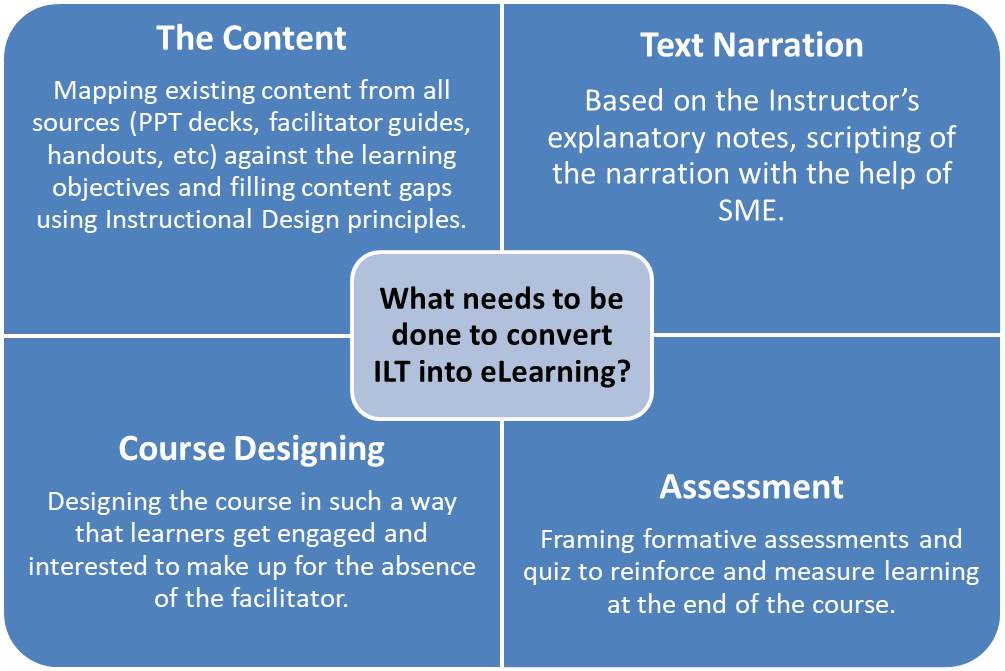
Courtesy: https://elearningindustry.com/
TRANSITION FROM INSTRUCTOR-LED TO eLEARNING
Converting ILT (Instructor-Led Training) to eLearning involves transforming traditional in-person training into an online format. Mindklick accepts existing classroom material or legacy courses in whatever form they are available SOPs, PDFs, eBooks, documents or ILT handouts and digitize course contents, adding multimedia elements, creating interactive activities and assessments, making the training accessible through online platforms or LMS. The aim is to provide learners with flexible access to training materials, allowing them to learn at their own pace while maintaining or improving the effectiveness of the training program.
Before we talk about transition from
Instructor-Lead Training to eLearning
Lets see why you should do it?
Classroom Instructor-Led Training (ILT) doesn’t really seem to be a viable option anymore due to its high logistics cost (travel, venue, etc), non-availability of trainers,
Gathering learners and instructors at one place at the scheduled time – and in the process disturbing the productivity of employees – etc. Against this, eLearning has lot of benefits and we have structured these benefits into two levels (click them to reveal details
Benefit to the Organization
Cost Saving
The main advantage organizations gain from converting ILT courses to eLearning is cost savings. By investing in the conversion process once, online training can be used multiple times, eliminating the need for additional expenses such as travel and instructor fees.
Scalability
The second important benefit for organizations is the potential for scalability provided by online training. With a single version of the training, they can now reach their entire audience, regardless of geographical location, all at once.
Consistency
Unlike traditional instructor-led training (ILT), where the effectiveness of the training depends on each individual trainer's capabilities, eLearning ensures that all learners receive the same message consistently and without variation.
Leverage New & Emerging Trends
Organizations now have a wealth of learning strategies at their disposal with the rise of Millennials in the workforce. In addition to converting ILT courses to online formats, they can maximize impact and return on investment by incorporating popular approaches such as: microlearning, mobile learning, and gamification (Explore them under "Features" Tab).
Higher Training Efficiency
Show that adoption of online training improves training efficiency. Not only do the learners go through more training material (as compared to ILT), this is done in a shorter time with much lesser disruption to their time on work.
Benefit to the learner
Flexibility
eLearning offers learners the convenience of "learning on the go," with anytime-anywhere access. This flexibility is the significant benefit from the learner's perspective.
Control
eLearning is learner-centric by nature. Its self-paced structure gives learners the freedom to take training at their preferred time, on their preferred device, and at their own comfortable pace. Additionally, online training is always accessible for reference or review purposes.
Short Seat Time
When you convert ILT to online, you'll discover that eLearning programs’ run length is much shorter. In fact, they can be reduced by approximately 50% or even as much as 33%. As a result, learners are achieving the same learning outcomes in significantly less time.
Continuous Learner Engagement
Online training allows continuous engagement of the learners, unlike ILT which typically ends with conclusion of the facilitated session. After the primary training is over, you can create learning paths to offer reinforcement/remediation and supplementary learning nuggets.
Higher Retention of Learning
Retention levels of eLearning-based training are significantly higher than those of ILT sessions, as several studies indicate. For example, a study conducted by the Research Institute of America in 2014 revealed retention rates ranging from 25-60% for eLearning, while face-to-face training had a mere 8-10% retention rate. This increased retention directly contributes to the return on investment (ROI) of training.
What we do to convert ILT into eLearning?

Are you ready to move from ILT to eLearning?
Lets check!
If yes, you are good to go!